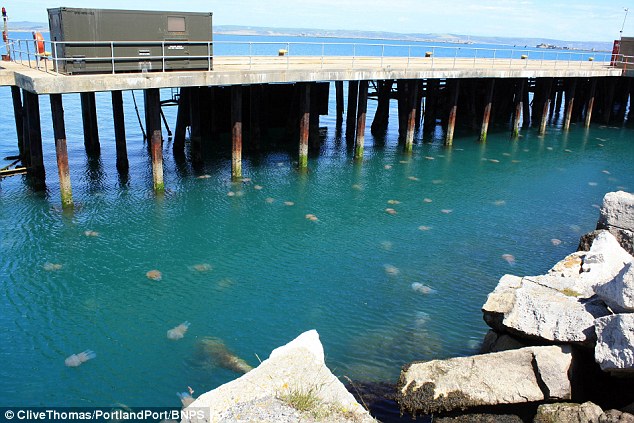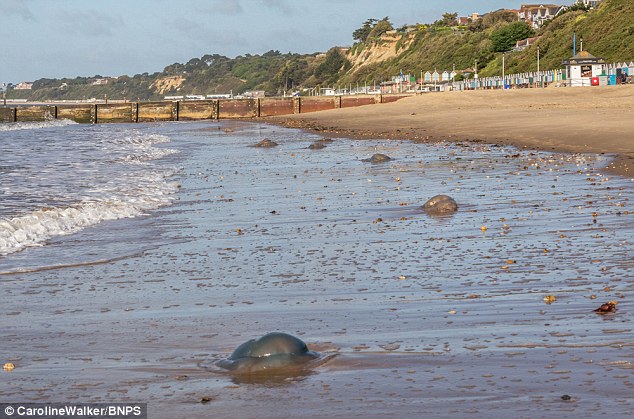
Port worker Clive Thomas managed to capture photos of the giant jellyfish in Portland Harbour in Dorset, while dozens more have been found washed up further along the coast in Bournemouth.
In one morning alone, lifeguards in Bournemouth recovered more than 100 jellyfish which had beached themselves.
Despite their large size, barrel jellyfish - which are called Rhizostoma pulmo in Latin - cause little harm to humans as their sting is not considered powerful. It is similar to a nettle sting and can cause a rash.
The recent influx to British shores is down to rich nutrients presently in the water which create ideal conditions for plankton to bloom.
The jellyfish are attracted towards the shore by the plankton but strong southerly winds often mean they end up being swept into the shallows.

He said: 'We get jellyfish coming here every so often but I have never seen them in such great number before.
'I videoed just one part of the harbour but they were everywhere. They do look a bit alien-like and the scene did look a bit spooky. You wouldn't have wanted to jump in.'
Beachgoers in Bournemouth also reported seeing dozens of the giant jellyfish washed up on a stretch of coastline.
Caroline Walker, from Canford Cliffs, Poole, was walking at Branksome Chine beach near the millionaire's playground of Sandbanks when she spotted an influx of the huge marine creatures stranded on the sand.
She said: 'I live near the beach and was down early in the morning with my camera to see what I came across when I spotted all these jellyfish high and dry on the shore.
'In just one section of beach between groynes there were 15 jellyfish - it was quite a sight.
'They ranged in shapes and size, from ones that would fit in the palm of your hand to others that were about 2ft wide.
'Barrel jellyfish aren't uncommon but we've been getting more and more being washed up recently.
'I first saw one around a month ago but since then the numbers have been going through the roof and in the last week there have been hundreds.
'Unfortunately once they've been washed up they then die. I saw a man from the council putting them in bags, and he said he'd collected 100 that morning.'
Barrel jellyfish are often known as dustbin-lid jellyfish because of their enormous size.
They are commonly found in the north east Atlantic, Adriatic, and Mediterranean and are thought to be among the oldest species on the planet, dating back around 500 million years.
Dr Simon Boxall, a lecturer oceanography at the University of Southampton, said: 'You get swarms of jellyfish when the conditions are right. We have had a combination of rain and sun in the spring and that leads to a reasonable amount of food in the water.
'Nutrients wash off the land into the sea that feed the plankton which feeds the jellyfish.
'Jellyfish do drift and go with the flow. They are at the mercy of the winds and that is why they do beach.
'People should avoid swimming in the sea if there are in large numbers. If people do get stung they are best off bathing the sting in salt water.'



Reader Comments
to our Newsletter